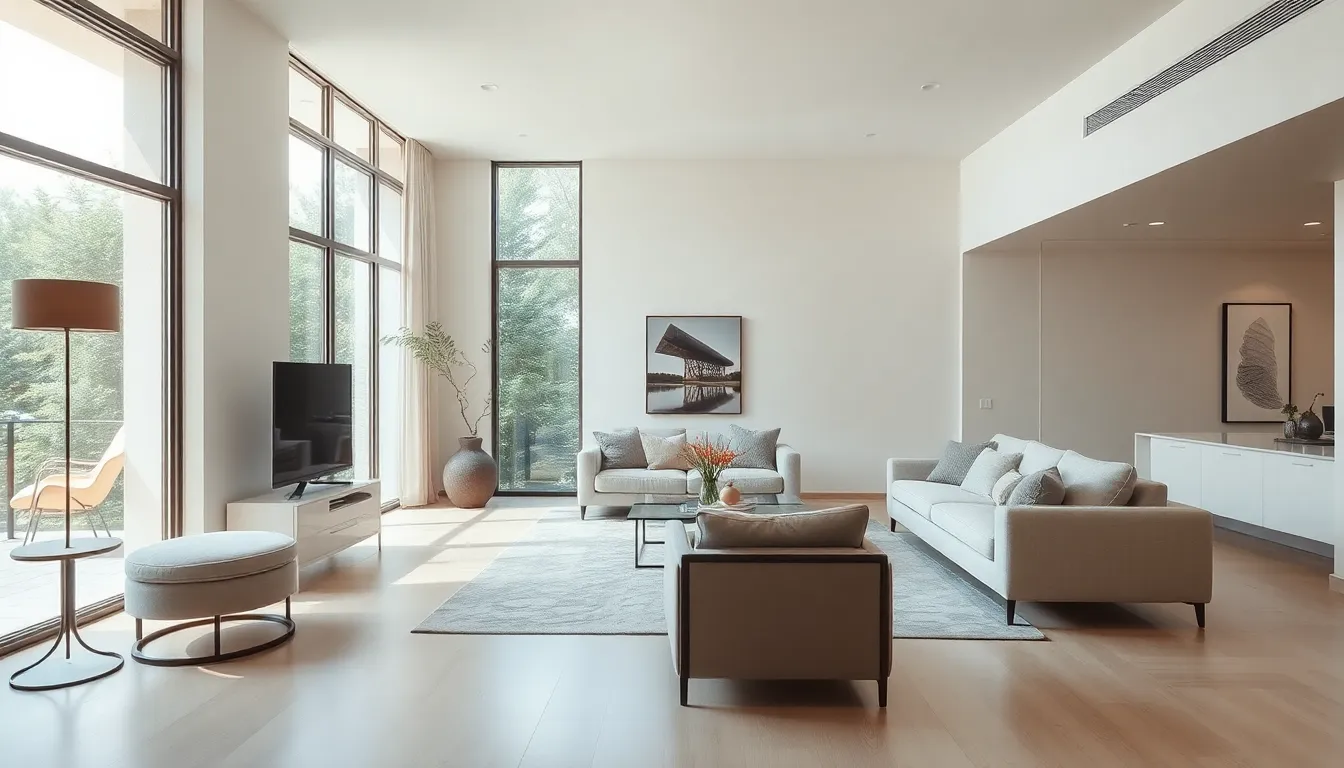Contemporary design isn’t just a trend; it’s a lifestyle choice that screams sophistication while keeping things refreshingly simple. Imagine stepping into a space where clean lines and innovative materials dance together in perfect harmony. It’s like a well-choreographed ballet, but with furniture instead of tutus.
Table of Contents
ToggleOverview Of Contemporary Design
Contemporary design emphasizes a balance between form and function. Defined by its clean lines, it encourages open spaces that promote light and air circulation. A blend of minimalism and soft, inviting textures characterizes the aesthetic.
Materials play a crucial role in this design style. Commonly used materials include glass, steel, and wood, fostering an innovative yet approachable ambiance. Color palettes often feature neutrals with strategic pops of color, offering visual interest without overwhelming the space.
Furniture selections prioritize simplicity and versatility. Designs often showcase geometric shapes, ensuring a modern feel that enhances usability. Each piece functions not only as an object but also as an integral part of the overall design concept.
Textures contribute depth and character to contemporary environments. Incorporating soft fabrics, smooth surfaces, and natural elements enriches the sensory experience. Such variations prevent spaces from appearing overly sterile, creating a livable atmosphere.
Sustainability has become increasingly important in contemporary design. Eco-friendly materials and energy-efficient practices influence how designers create functional yet stylish spaces. Awareness of the environment shapes choices, emphasizing a responsible approach to building and furnishing.
Lighting serves as both a practical and aesthetic element in contemporary spaces. Fixtures often feature sleek designs that highlight architectural features while providing adequate illumination. Natural light remains paramount, bringing warmth and vibrancy into the home.
Contemporary design represents a dynamic approach to space that marries beauty with utility. It promotes environments that feel fresh, inviting, and reflective of modern living. Through thoughtful choices, it achieves a timeless appeal while embracing innovation.
Key Characteristics Of Contemporary Design

Contemporary design embodies essential traits that create its unique aesthetic and functionality. Key aspects include minimalism and functionality, both pivotal in achieving a harmonious living environment.
Minimalism
Minimalism defines contemporary design through its focus on simplicity. Spaces benefit from clean lines that remove distractions. Utilization of open areas fosters an uncluttered look, allowing light to create balance. Functionality stems from restrained decor choices, emphasizing quality over quantity. Accessories retain significance while avoiding excess. A limited color palette often highlights neutrals, promoting tranquility. Texture additions, such as soft fabrics, enhance warmth without overwhelming. By streamlining elements, contemporary design cultivates a serene atmosphere aligned with modern living.
Functionality
Functionality serves as a cornerstone of contemporary design principles. Emphasis on usability ensures that each item serves a purpose. Spaces encourage movement, making them suitable for social interactions and daily activities. Modular furniture options support versatile arrangements, adapting to various needs. The incorporation of intelligent storage solutions maximizes space utility, keeping areas organized yet stylish. Natural light takes center stage, enhancing ambiance and visibility. Selection of eco-friendly materials reflects sustainable choices that enhance both aesthetic appeal and practicality. Contemporary design achieves a blend of comfort and efficiency, resonating with today’s lifestyle demands.
Influential Designers In Contemporary Design
Contemporary design is significantly shaped by visionary designers whose work pushes boundaries. These influential figures blend creativity with practicality, enhancing both aesthetics and functionality.
Notable Names
Renowned designers like Zaha Hadid, known for her fluid architectural forms, showcase innovation in contemporary design. Tadao Ando emphasizes minimalism and blends nature with structure through his concrete creations. Philippe Starck’s playful designs merge function with whimsy, making high-end products accessible. Patricia Urquiola captivates with her use of organic shapes and vibrant colors, reflecting the warmth of contemporary spaces. Each designer contributes unique interpretations, leading to a rich tapestry of modern design.
Their Impact On The Industry
Zaha Hadid’s architectural projects challenge conventional norms and inspire architects globally. Tadao Ando’s philosophy of simplicity influences sustainable design practices, merging elegance with environmental consciousness. Philippe Starck’s approach democratizes design by creating luxurious yet affordable items, expanding accessibility. Patricia Urquiola’s work highlights the importance of emotional connections within spaces, prompting designers to prioritize user experience. Collectively, these designers advance contemporary design, instigating trends that resonate within residential and commercial environments.
Trends Shaping Contemporary Design
Contemporary design evolves continuously, reflecting societal shifts and innovations. Two prominent trends currently shaping this field are sustainability and technology integration.
Sustainability
Sustainability plays a crucial role in contemporary design, driven by the demand for eco-friendly practices. Designers increasingly favor renewable materials, such as bamboo and reclaimed wood, which minimize environmental impact. Energy-efficient products, like LED lighting and low-voc paints, optimize energy consumption, contributing to greener spaces. Integration of indoor plants enhances air quality while adding natural beauty, creating a harmonious atmosphere. Additionally, sustainable design promotes local sourcing, supporting community economies and reducing carbon footprints. These choices reflect a commitment to environmental awareness and resonate well with modern consumers who value ecological responsibility.
Technology Integration
Technology integration enhances contemporary design, offering innovative solutions for both aesthetics and functionality. Smart home features, such as automated lighting and climate control, streamline daily living while elevating convenience. Augmented reality tools assist in visualizing spaces, enabling better decision-making for homeowners and designers alike. Connectivity also influences furniture design, with modular pieces that adapt to various needs and lifestyles. Modern materials, like responsive textiles, can adjust to environmental changes, enhancing comfort. These advancements not only create efficient living environments but also foster an interactive relationship between occupants and their spaces.
Contemporary design stands as a testament to modern living that values both aesthetics and functionality. It embraces innovative materials and sustainable practices while fostering open spaces that invite light and air. The influence of leading designers is evident in the way they challenge traditional norms and prioritize eco-friendly solutions. As technology continues to evolve it seamlessly integrates into design, enhancing the overall experience of living spaces. This dynamic approach not only reflects current trends but also shapes the future of how individuals interact with their environments. Embracing contemporary design means choosing a lifestyle that harmonizes beauty with purpose.





